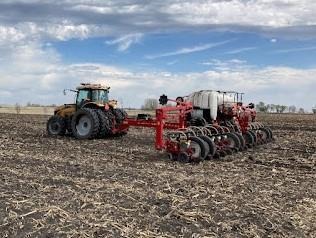By Phyllis Bongard
As fertilizer and herbicide costs increase, what kind of strategies can growers use to tame these input costs in 2022? Brad Carlson, Extension educator and Dan Kaiser, Extension nutrient management specialist joined Extension weed scientists Tom Peters and Debalin Sarangi for the final webinar of the series. The March 30 session of Strategic Farming: Let’s talk crops! was moderated by Extension Educators Dave Nicolai and Liz Stahl.

Photo: Jared Goplen
Taming nutrient management input costs
With planting dates quickly approaching, Carlson gave a quick recap on current conditions. In an average year in Waseca, frost is typically out of the soil at 6-inches in March. This year, however, soil is still frozen at 12 inches. Take a look at the National Weather Service’s Frost depth map for more information.
A significant portion of eastern Minnesota still has a moisture deficit going into the growing season. While much of the western half of the state experienced significant drought in 2021, rains in late summer erased the soil moisture deficit.
Nitrogen
Due to last year’s drought, there is potential for significant carryover of soil nitrate this spring. Coupled with the high fertilizer prices, growers may have the opportunity to use that residual nitrate in their total fertilizer package going into 2022. There are two scenarios where the University of Minnesota highly recommends taking a preplant soil nitrate test: The first is in fields with long-term manure application histories, because of the increased potential for organic matter mineralization. Corn on corn is the second situation where soil nitrate tests are highly recommended. For more information, see the section on soil nitrate tests in Fertilizing corn in Minnesota.
An independent lab shared results from soil nitrate samples taken last fall. Roughly 70% showed a nitrogen credit with some showing credits well above 100 lb/a. Will that nitrate be available this spring? A lot will depend on the weather conditions this spring, since nitrate is mobile and moves with water.
Growers that aren’t planning to test soil nitrate levels should see the N rate guidelines in Fertilizing corn in Minnesota.
What about nitrogen stabilizers for 2022? The odds of losing nitrogen between application and early June to denitrification aren’t high, so nitrification inhibitors may not play a significant role in 2022. However, urease inhibitors can be beneficial when there’s little water to move urea into the soil or when it’s shallowly incorporated.
Phosphorus and potassium
With phosphorus and potassium, potential fertilizer savings will depend on soil test values. Medium to high soil test levels, particularly of phosphorus, offers some flexibility in fertilizer applications. If P levels are built to 20 ppm or above, applying in-furrow starter instead of broadcasting P will help tame costs.
Potassium application is trickier, especially in dry years as starter application may not be enough if soils test less than 200 ppm. Read the discussion on changes in P and K soil test values in Fertilizing corn in Minnesota.
Taming weed control costs
Regulatory recap
EPA endangered species
The restrictions for applying Enlist Duo in six Minnesota counties were lifted on March 29. The restrictions for Enlist Duo, but not Enlist One, were put in place in January. Both formulations can now be used in the state in 2022.
Dicamba restrictions
Cut-off dates for dicamba applications to dicamba-tolerant (DT) soybean have tightened in 2022. South of I-94, the cutoff date for applications to DT soybean is now June 12. North of I-94, the cutoff date is June 30. In addition to the date cutoffs, dicamba formulations for DT soybean cannot be applied if the maximum daytime temperature reaches or exceeds 85F.
Weed management strategies
Weed management strategies are a bit like a chess game since fields are unique. Though earlier reports suggested there may be herbicide shortages this season, the bigger challenge is managing weeds when herbicide costs are high.
Know your weeds!
Identifying weeds isn’t easy, but critical to controlling them. Herbicides that work on pigweeds, for example, may not control kochia and common or giant ragweed, so misidentification could be costly. See Weed identification for descriptions, photos, and more information.
Learning the characteristics that make one weed different from another is also important for managing them effectively. For example, what are their emergence patterns? Giant ragweed emerges early in the spring and could potentially be controlled through spring tillage and a later soybean planting date. In contrast, waterhemp will emerge throughout the season and requires a more complex strategy.
Use preemergence herbicides
In addition to being less expensive, preemergence (PREs) herbicides are very effective and provide a strong foundation for the growing season. Since they take out early season weeds, PREs make it easier to implement a postemergence (POST) strategy. They buy extra time and take pressure off of the POST applications, something that can be especially important if herbicide availability might be an issue.
Some PREs need to be incorporated into the soil through timely rainfall or light tillage. Peters cautions against incorporating herbicides too deep, since many of our troublesome weed seeds, including pigweed species, reside in the top 1-inch of soil.
Tank mixing soil residual and postemergence (foliar-active) herbicides broadens control and can be another good management option, depending on weed species and costs.
Growers should consider which tools they have and whether they might want to save more expensive herbicides for certain fields. For more information on herbicide effectiveness, see the North Dakota Weed Control Guide.
Strategic Farming recordings available
If you’d like to watch the webinar recordings or review additional resources, visit z.umn.edu/strategic-farming.
Join us for Field Notes this growing season!
The Field Notes program is designed for farmers and agricultural professionals as a weekly webinar addressing the season's crop-related questions in an interactive, discussion-based format. Field Notes will begin May 11 and run through August. Watch Crop News for details and registration information.
Source : umn.edu